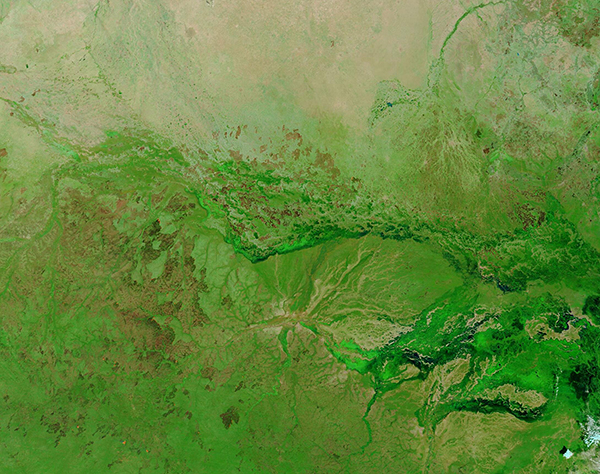Images
December 5, 2022 - Burn Scars in Sudan and South Sudan
Tweet
On November 28, 2022, the Moderate Resolution Imaging Spectroradiometer (MODIS) on board NASA’s Terra satellite acquired a remarkable false-color image showing burn scars scattered southern Sudan and northwestern South Sudan.
Most of the land visible belongs to South Sudan, including the wetlands near the White Nile River and rich agricultural lands to the west of the wetlands. To the north, the landscape of Sudan changes rapidly from the green at the border with South Sudan to more arid land at the edge of the Sahara Desert.
By using visible and near-infrared light (bands 7,2,1) burn scars – which may appear black, brown, or brick red - stand out in stark contrast to vegetation, which appears bright green. Open land appears tan, deep water is colored deep blue and clouds, when present, may appear either white or tinted with electric blue. The color variation in burn scars depends on type of vegetation burned, the completeness of the burn, the amount of residue remaining after the burn, and the age of the burn. Fresh burn scars most often appear black or brick red, while older scars, where vegetation has begun to regrow, become lighter and eventually tinted with green.
In this image, burn scars are abundant across all of the bright green (vegetated) areas, especially along the Sudan-South Sudan border, while the vegetation near the darkly-colored waters of the White Nile and associated wetlands show little scarring. The heavily-burned areas sit in the location where traditional agriculture is practiced. Farmers in this location have used fire to clear new land for fresh cropping, to clear stubble from harvested fields in preparation for planting the next crop, and to renew pasture for centuries. The multiple shades of burn scars give evidence of fires burning in this area over many years.
Image Facts
Satellite:
Terra
Date Acquired: 11/28/2022
Resolutions:
1km (316.7 KB), 500m (810.2 KB), 250m (507.4 KB)
Bands Used: 7,2,1
Image Credit:
MODIS Land Rapid Response Team, NASA GSFC
Tweet
On November 28, 2022, the Moderate Resolution Imaging Spectroradiometer (MODIS) on board NASA’s Terra satellite acquired a remarkable false-color image showing burn scars scattered southern Sudan and northwestern South Sudan.
Most of the land visible belongs to South Sudan, including the wetlands near the White Nile River and rich agricultural lands to the west of the wetlands. To the north, the landscape of Sudan changes rapidly from the green at the border with South Sudan to more arid land at the edge of the Sahara Desert.
By using visible and near-infrared light (bands 7,2,1) burn scars – which may appear black, brown, or brick red - stand out in stark contrast to vegetation, which appears bright green. Open land appears tan, deep water is colored deep blue and clouds, when present, may appear either white or tinted with electric blue. The color variation in burn scars depends on type of vegetation burned, the completeness of the burn, the amount of residue remaining after the burn, and the age of the burn. Fresh burn scars most often appear black or brick red, while older scars, where vegetation has begun to regrow, become lighter and eventually tinted with green.
In this image, burn scars are abundant across all of the bright green (vegetated) areas, especially along the Sudan-South Sudan border, while the vegetation near the darkly-colored waters of the White Nile and associated wetlands show little scarring. The heavily-burned areas sit in the location where traditional agriculture is practiced. Farmers in this location have used fire to clear new land for fresh cropping, to clear stubble from harvested fields in preparation for planting the next crop, and to renew pasture for centuries. The multiple shades of burn scars give evidence of fires burning in this area over many years.
Image Facts
Satellite:
Terra
Date Acquired: 11/28/2022
Resolutions:
1km (316.7 KB), 500m (810.2 KB), 250m (507.4 KB)
Bands Used: 7,2,1
Image Credit:
MODIS Land Rapid Response Team, NASA GSFC




